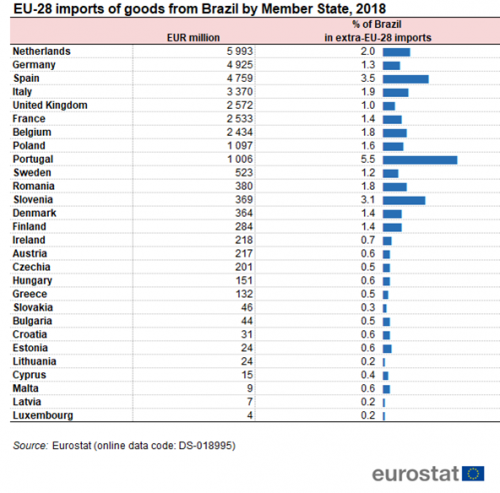Archive:Brazil-EU – international trade in goods statistics
Data extracted in March 2019.
Planned article update March 2020.
Highlights
Imports, exports and trade balance in goods between the EU and Brazil, 2008-2018
This article provides a picture of the international trade in goods between the European Union (EU) and Brazil. It analyses the type of goods exchanged between the two economies and the shares of each EU Member State in those exchanges.
This article is part of an online publication providing recent statistics on international trade in goods, covering information on the EU's main partners, main products traded, specific characteristics of trade as well as background information.
Full article
EU and Brazil in world trade in goods
Figure 1a shows the position of Brazil among the largest traders in the world. The four largest exporters were China (EUR 2 004 billion, 16 %), the EU (EUR 1 879 billion, 15 %), the United States (EUR 1 368 billion, 11 %) and Japan (EUR 618 billion, 5 %). The four largest importers were the United States (EUR 2 131 billion, 17 %), the EU (EUR 1 857 billion, 15 %), China (EUR 1 632 billion, 13 %) and Japan (EUR 594 billion, 5 %). Figure 1b has some more details. It shows that Brazil (EUR 193 billion, 2 %) was the 17th largest exporter in the world between Thailand (EUR 193 billion, 2 %) and Malaysia (EUR 192 billion, 2 %). It was the 21st largest importer in the world (EUR 133 billion, 1 %) between Indonesia (EUR 139 billion, 1 %) and Saudi Arabia (EUR 127 billion, 1 %).

source: Eurostat (ext_lt_introle)
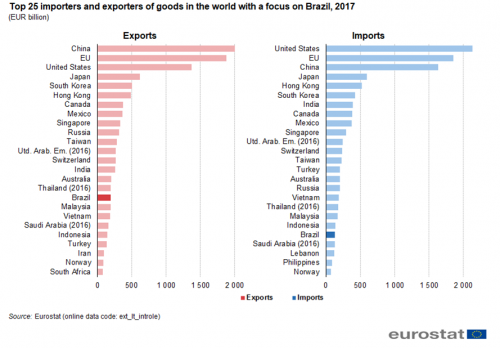
source: Eurostat (ext_lt_introle)
Figure 2 shows the imports and exports of the EU and Brazil indexed at 100 in 2007 for the period to 2017. It also shows the cover ratio (exports / imports) for this period. Exports from the EU were lowest in 2009 (89) and highest in 2017 (152). Imports to the EU were lowest in 2009 (85) and highest in 2017 (128). The cover ratio for the EU was lowest in 2008 (83 %) and highest in 2015 (104 %) and was 101 % in 2017. Exports from Brazil were lowest in 2009 (94) and highest in 2017 (164). Imports to Brazil were lowest in 2007 (100) and highest in 2013 (205) and was 152 in 2017. The cover ratio for Brazil was lowest in 2014 (98 %) and highest in 2017 (144 %).

source: Eurostat (ext_lt_introle)
Growing exports to but falling imports from Brazil
Figure 3a shows the position of Brazil among the largest trade partners of the EU. The four largest export partners of the EU were the United States (21 %), China (11 %), Switzerland (8 %) and Russia (4 %). The four largest import partners of the EU were China (20 %), the United States (13 %), Russia (8 %) and Switzerland (6 %). Figure 3b has some more details. It shows that Brazil (EUR 34 billion, 1.7 %) was the 16th largest export partner of the EU, between Australia (EUR 36 billion, 1.8 %) and Saudi Arabia (EUR 30 billion, 1.6 %). In imports Brazil (EUR 32 billion, 1.6 %) was the eleventh largest partner of the EU, between Vietnam (EUR 38 billion, 1.9 %) and Canada (EUR 31 billion, 1.6 %).
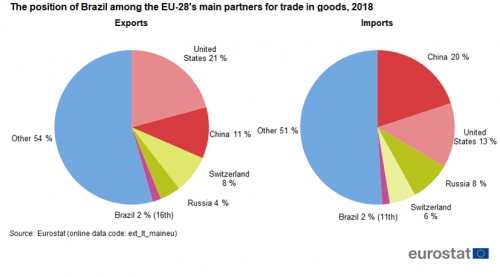
source: Eurostat (ext_lt_maineu)

source: Eurostat (ext_lt_maineu)
Figure 4 shows exports, imports and trade balance between the EU and Brazil. In 2008 the EU had a trade deficit with Brazil of EUR 10 billion. This changed to a surplus in 2012 and remained so until 2018 when it reached EUR 2 billion. EU exports to Brazil were highest in 2013 (EUR 40 billion) and lowest in 2009 (EUR 22 billion). EU imports from Brazil were highest in 2011 (EUR 40 billion) and lowest in 2009 (EUR 26 billion).
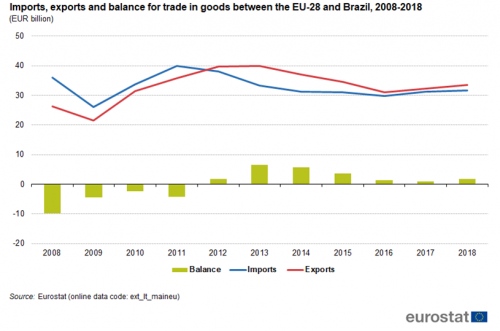
source: Eurostat (ext_lt_maineu)
EU-Brazil trade by type of goods
Figure 5 shows the breakdown of EU trade with Brazil by SITC groups. The red colours denote the primary products: food & drink, raw materials and energy, while the blue colours show the manufactured goods: chemicals, machinery & vehicles and other manufactured goods. Finally, other goods are shown in green. In 2018, EU exports of manufactured goods (85 %) had a higher share than primary goods (11 %). The most exported manufactured goods were machinery & vehicles (41 %), followed by chemicals (27 %) and other manufactured products (17 %). In 2018, EU imports of primary goods (68 %) had a higher share than manufactured goods (28 %). The most imported primary goods were raw materials (31 %), followed by food & drink (30 %) and energy (7 %).
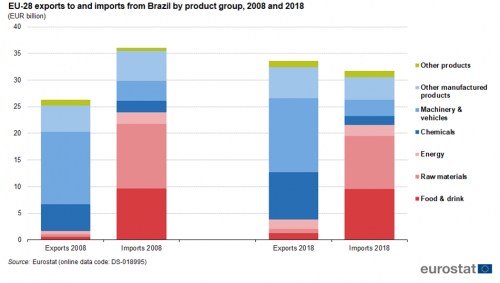
source: Eurostat DS-018995
Figure 6 shows the evolution of EU imports and exports by SITC group since 2008. In 2018, the EU had trade surpluses in machinery & vehicles (EUR 10.8 billion), chemicals (EUR 7.2 billion) and other manufactured products (EUR 1.6 billion). The EU had trade deficits in energy (EUR 0.4 billion), food & drink (EUR 8.2 billion) and raw materials (EUR 9.2 billion) and was in balance for other products (EUR 0.0 billion).

source: Eurostat DS-018995
EU-Brazil most traded goods
Another interesting way to look at the data is to investigate the cover ratio (exports / imports) of traded goods, showing the direction of the trade flows between the two economies. These ratios can be found in the right-hand margin of Figure 7. Eleven products have ratios below 50, indicating EU imports from Brazil are at least twice a large as EU exports to Brazil. Eight products have ratios above 200, indicating EU exports to Brazil are at least twice as large as EU imports from Brazil. One product has a ratio between 50 and 200, showing more balanced trade.
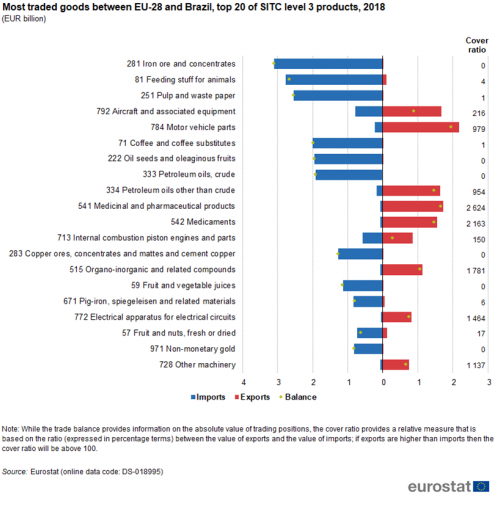
source: Eurostat DS-018995
Trade with Brazil by Member State
Figure 8a shows the EU imports from Brazil by Member State. The three largest importers from Brazil in the EU were the Netherlands (EUR 5 993 million), Germany (EUR 4 925 million) and Spain (EUR 4 759 million). Portugal (6 %) held the highest share for Brazil in its total extra-EU imports.
Figure 8b shows the EU exports to Brazil by Member State. The three largest exporters to Brazil in the EU were Germany (EUR 9 454 million), France (EUR 4 769 million) and Italy (EUR 3 878 million). Portugal (6 %) held the highest share for Brazil in its total extra-EU exports.
Figure 8c shows the trade balance between the EU Member States and Brazil. Fourteen Member States had a trade surplus with Brazil. The largest was held by Germany (EUR 4 528 million), followed by France (EUR 2 236 million) and Belgium (EUR 784 million). Fourteen Member States had a trade deficit with Brazil. The largest was held by the Netherlands (EUR 3 313 million), followed by Spain (EUR 2 336 million) and Poland (EUR 683 million).
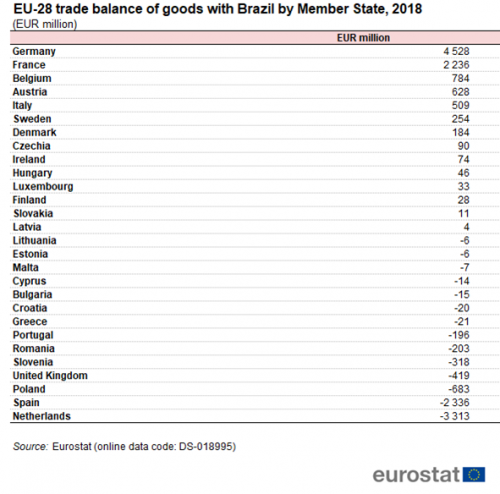
source: Eurostat DS-018995
Source data for tables and graphs
Data sources
EU data is taken from Eurostat's COMEXT database. COMEXT is the reference database for international trade in goods. It provides access not only to both recent and historical data from the EU Member States but also to statistics of a significant number of third countries. International trade aggregated and detailed statistics disseminated via the Eurostat website are compiled from COMEXT data according to a monthly process.
Data are collected by the competent national authorities of the Member States and compiled according to a harmonised methodology established by EU regulations before transmission to Eurostat. For extra-EU trade, the statistical information is mainly provided by the traders on the basis of customs declarations.
EU data are compiled according to Community guidelines and may, therefore, differ from national data published by the Member States. Statistics on extra-EU trade are calculated as the sum of trade of each of the 28 EU Member States with countries outside the EU. In other words, the EU is considered as a single trading entity and trade flows are measured into and out of the area, but not within it.
Data for the other major traders are taken from the Comtrade database of the United Nations. Data availability differs among countries, therefore Figure 1 shows the latest common available year for all the main traders. For the calculation of shares the world trade is defined as the sum of EU trade with non-EU countries (source: Eurostat) plus the international trade of non-EU countries (source: IMF Dots database).
Methodology According to the EU concepts and definitions, extra-EU trade statistics (trade between EU Member States and non-EU countries) do not record exchanges involving goods in transit, placed in a customs warehouse or given temporary admission (for trade fairs, temporary exhibitions, tests, etc.). This is known as ‘special trade'. The partner is the country of final destination of the goods for exports and the country of origin for imports.
Product classification Information on commodities exported and imported is presented according to the Standard international trade classification (SITC). A full description is available from Eurostat's classification server RAMON.
Unit of measure Trade values are expressed in millions or billions (109) of euros. They correspond to the statistical value, i.e. to the amount which would be invoiced in case of sale or purchase at the national border of the reporting country. It is called a FOB value (free on board) for exports and a CIF value (cost, insurance, freight) for imports.
Context
Trade is an important indicator of Europe’s prosperity and place in the world. The bloc is deeply integrated into global markets both for the products it sources and the exports it sells. The EU trade policy is an important element of the external dimension of the ‘Europe 2020 strategy for smart, sustainable and inclusive growth’ and is one of the main pillars of the EU’s relations with the rest of the world.
Because the 28 EU Member States share a single market and a single external border, they also have a single trade policy. EU Member States speak and negotiate collectively, both in the World Trade Organization, where the rules of international trade are agreed and enforced, and with individual trading partners. This common policy enables them to speak with one voice in trade negotiations, maximising their impact in such negotiations. This is even more important in a globalised world in which economies tend to cluster together in regional groups.
The openness of the EU’s trade regime has meant that the EU is the biggest player on the global trading scene and remains a good region to do business with. Thanks to the ease of modern transport and communications, it is now easier to produce, buy and sell goods around the world which gives European companies of every size the potential to trade outside Europe.
Direct access to
- International trade in goods (t_ext_go), see:
- International trade in goods - long-term indicators (t_ext_go_lti)
- International trade in goods - short-term indicators (t_ext_go_sti)
- International trade in goods (ext_go), see:
- International trade in goods - aggregated data (ext_go_agg)
- International trade in goods - long-term indicators (ext_go_lti)
- International trade in goods - short-term indicators (ext_go_sti)
- International trade in goods - detailed data (detail)
- EU trade since 1988 by SITC (DS-018995)
- International trade in goods statistics - background
- International trade in goods (ESMS metadata file — ext_go_agg_esms)
- User guide on European statistics on international trade in goods
- European Commission
